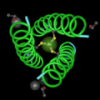Liveblogging from the Hi-Tec conference
I'm currently at the Hi-Tec conference in Scottsdale, Arizona. (If you follow me on Twitter - www.twitter.com/@digitalbio - you may have seen me complaining about the temperature). It's an interesting conference, so I'm going to share some of the things that I'm learning.
Dr. Travis Benanti and Dr. Steve Fonash from Penn State University are presenting an interesting session this morning on nanotechnology.
Luckily, you don't have to know anything about nanotechnology to find the session fascinating.
If you're interested in learning about nanotechnology or teaching
about this, they have free modules and courses available at their web
site, www.nano4me.org , and they will also post the slides from this morning's talk.
What is nanotechnology?
Certainly it's a catchy term but it's not clear what it is exactly,
at least not to me, so I appreciated the level of the talk and clear
explanations.
First, we heard from Dr. Fonash. In Italian, "nano" means "dwarf." In science 1 nanometer is 0.000000001 meters (or 10-9 meters).
What are the unique attributes of the nanoscale?
- huge surface to volume ratio - as a result, most of the atoms are on the surface in a unique environment
- surface forces dominate over bulk forces - and GRAVITY is not important! [the emphasis is mine]
- quantum mechanical effects are important
- wave properties of light are important
- unique chemical bonding configurations are possible
- If we compare nanoparticles to viruses - a virus is a large nanoparticle
- molecules can self assemble in this size range
How old is nanotechnology?

- The Romans used nanotechnology 1700 years ago! The Lycurgus
Cup (above), in the British museum, has gold and silver nanoparticles
embedded in glass.
- The stained glass windows in European cathedrals (e.g. the Notre Dame in Paris) have nanoparticles.
- The Arabs were putting carbon nanoparticles in steel 1000 years ago (Damascus steel)
- Nanoparticles were put into ceramic plates in 16th century Italy.
- The ancient Phoenicians used sliver nanoparticles to treat infections.
We haven't been able to figure to figure out how to copy what the
ancient Roman, Arab, or European techniques but we have been able to
show that nanoparticles are in the materials.
Today, we use nanotechnology in many, many places. There are more
transistors made from nanoparticles than there are grains of rice.
One of the big tools is Electron Microscopy and we can use it to
make things. Nanotechnology uses lots of types of Electron microscopy
and we can both see atoms and push them around. You can even see the
probability density of the electrons! (in a quantum corral).
Transmission EM, Scanning ElEM (SEM), Field Emission Scanning
Electron Microscopy (FE-SEM), Atomic force electron microscopy and
scanning tunnel EM.
Transistors are made through nanotechnology. So are bikes. A BMC bicycle uses carbon nanotubes and weighs 2 pounds.
Nanotech in Energy
Dr. Travis Benanti talked about nanotechnology and energy. He
discussed the research for using nanotechnology can be used to improve
solar cells, which can help address energy problems. Current solar
cells have some problems because they're fragile, rigid, and expensive.
He also talked about quantum dots.
Nanotech in Medicine
Now we're hearing about cancer cells labeled with Quantum Dots. We saw a movie where cancer cells were grabbing EGF ( epidermal growth factor) and bringing it into the cell.
MRI imaging can can be enhanced using quantum dots.
The NCI has a web site with all kinds of movies showing the things that nanoparticles do in medicine.
Tumors can be targeted for killing by using nanoparticles. You would use the quantum dots to help you prove that the drugs attach and get taken inside the cell.
There are exciting things ahead for nanotech.

There are broadly two classes of nanotechnology:
Chemistry and "nano-construction/assembly".
Yeah, chemistry is the proper term for the vast majority of so called nano-tech. Materials science is incredibly important, after all we name epochs in human history after the predominant material science technology (we are living in the concrete age... not the "information age".)
Assembly type nanotech is very cool, but really micro scale is where we are at (not nano). Importantly, the production methods are completely different.
Anyways, it seem to me that conflating these two very different fields into one so called "nanotechnology" is worse than unhelpful. It is a bit like saying that paleontology and geology are both "rock-ology".
Hi travc,
I don't quite understand which two fields you think are being mixed up. Chemistry and nanotechnology?
Nanotechnology is a super-category including both:
1) chemistry of small particles (and some cool self-assembly chem)
and 2) the manufacture of small objects/devices using semiconductor and/or electron microscopy techniques.
The chemistry angle is potentially world changing important in the near or medium term. Scaling up the manufacture angle is generally much more long term (or perhaps not even feasible). I love Neil Stephenson's book The Diamond Age, but "universal constructors" are a good ways off at best.
MEMS (micro scale) devices often get called nanotech. Actually, a lot (most?) of the manufacture angle nanotech is really MEMS work playing buzzword bingo. MEMS devices are cool, and some are really useful. The accelerometer in newer laptops and cellphones are MEMS devices.
Thanks travc,
I have heard some of the debate about MEMS vs. nano. Thanks for the clarification.
I have seen video on new ways of curing cancer and I am wondering if anyone knows where I can find information on new technology putting protein inside diamonds and placing them on tumors. The video that I had seen before showed the diamonds disolving into the tumors.